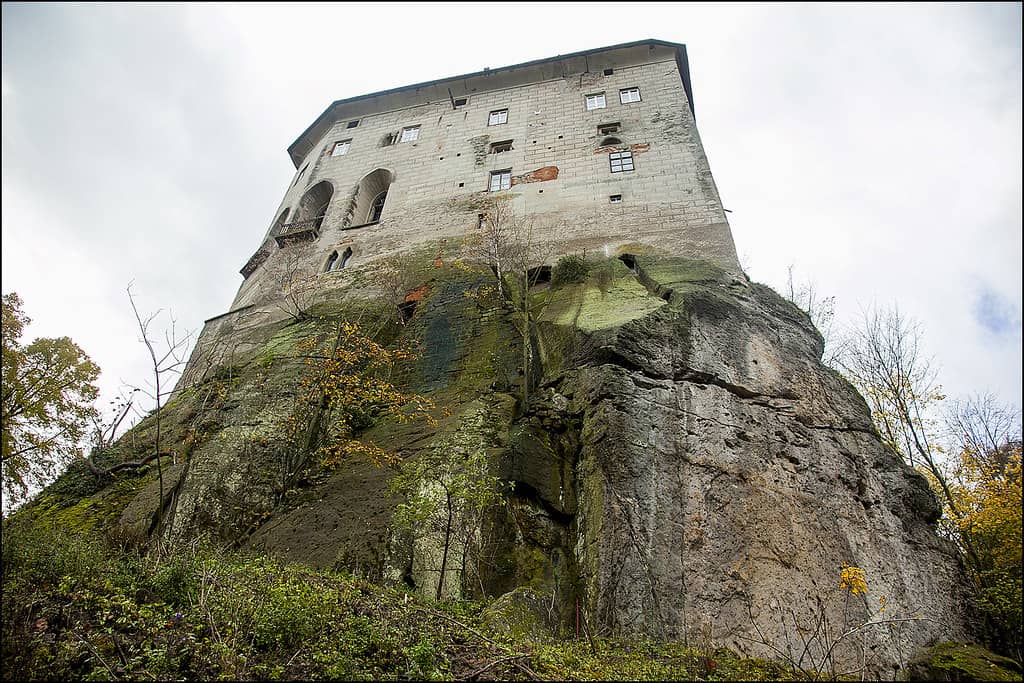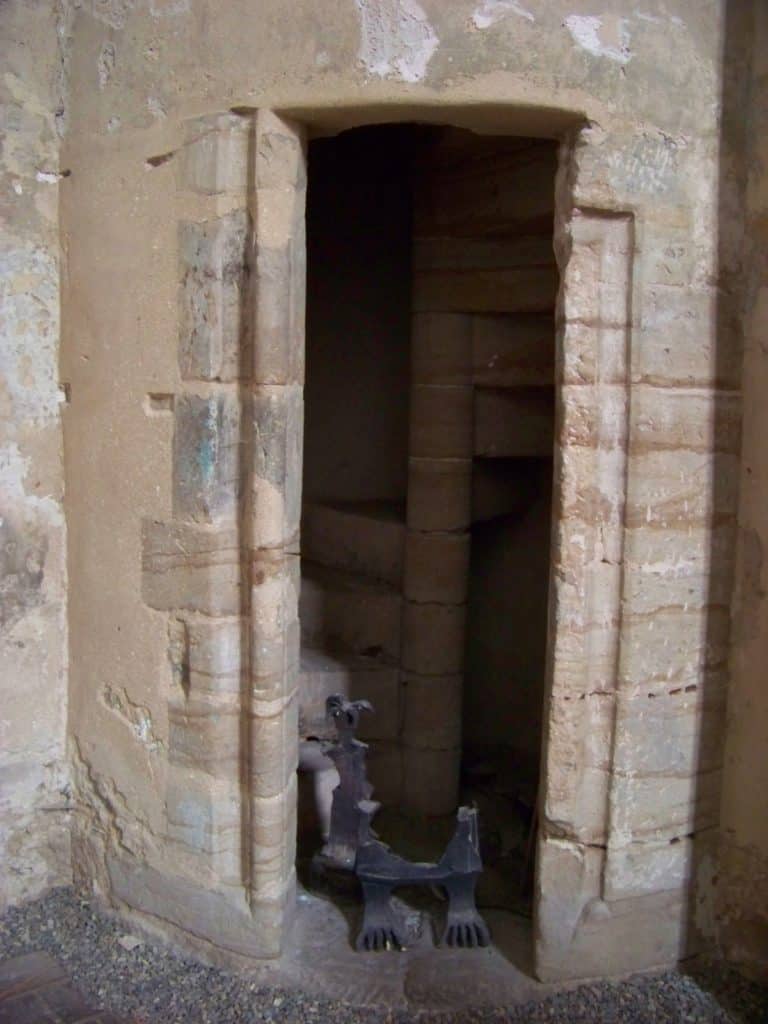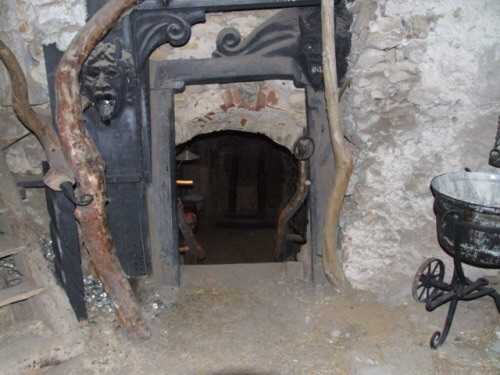
Many legends turn upon the story of the walls of this mystical castle. It has also always lured lovers of secrets. Why was it built on a place with no strategic importance and without any source of water – away from all trade paths? Supposedly, its purpose was to guard a gateway to hell leading through a bottomless well. Local people wanted to fill it with rocks to get rid of evil spirits. However, they were unsuccessful: So, they covered the place with thick stone plates and built a chapel over it. Its walls were always moist even during the terrible draughts. Since it was chosen as a residence by the Nazis during World War II, the evil spirit of this place is obvious…
Let’s discover with us the history and legends of Czech Houska Castle
On a forested hill, perched on the edge of a limestone cliff, stands Castle Houska. This ancient stone structure has for centuries held certain notoriety in the region of northern Bohemia in the Czech Republic. Why have local people always avoided the castle and surrounding area, fearing that some evil lurks there? Why is it that so many dead birds are so often found in the castle’s inner courtyard? Why was this castle built on a site that was historically covered with impenetrable woods, not even suitable for hunting, with no nearby borders or trade routes to defend? Why did the Swedish mercenary leader and black magician Oronto decide to make this castle his home and laboratory in 1639, and what was he doing there that terrified the local peasants so much that they assassinated him? Why was Houska Castle occupied by the occult-influenced Nazi SS during the Second World War when its location was of absolutely no strategic value? Indeed, Castle Houska has long been a place that inspires a sense of fear and mystery and which raises many questions. Definite answers, however, are few and mostly conjectural.
The legends surrounding the site of Houska Castle are older than the castle itself. There is archeological evidence of Celtic inhabitation in this area dating back into antiquity and Slavic tribes migrated here in the 6th Century. The first known structure existing on this site was a small wooden fort that stood here back in the 9th Century, mentioned by Václav Hájek in his extensive Czech Chronicle published in 1541. In the same chronicle, Hajek also recounts a legend, the story of a strange crack in the top of the limestone cliff, a hole in the ground unimaginably deep, and reputed to be the source of strange visitations. Local residents began calling it a Hole to Hell, and the villagers avoided passing anywhere near it after dark. They believed that strange creatures, half animal and half human, issued forth from the portal to kill livestock and wreak other havoc in the night. They also believed that any person who passed near the site was himself in danger of being changed into one of the creatures of the pit. They attempted to fill the hole with stones but with no success as it swallowed everything they dropped down it with no visible effect.
Avoid the crowds at Prague Castle with a mystery tour of alchemy and astrology, taking you to magical locations like New World, Strahov Monastery or Prague Loreto.
3 hour tour | from 26 €
Explore hidden places in Old Town and fill your evening with ghost stories and legends full of death, poverty, misery, or murder.
1,5 hour tour | from 16 €
Discover the history of psychiatry and learn about the development of Prague’s famous psychiatric hospital on its vast grounds.
3 hour tour | from 26 €
It’s reported that eventually a duke of the powerful Duba clan, in order to discover the secret behind the mysteries of the supposed gateway to Hell, offered a condemned prisoner a full pardon for his crimes if he would complete just one task: he had to consent to be lowered down into the bottomless pit on the end of a rope and to report back on what he found there. To this, the man readily agreed but once he had descended into the opening for quite some distance there came a long period of silence and then the convict began screaming uncontrollably from deep within the ground. When the duke’s men pulled the convict back to the surface, they found that his hair had turned completely white and he was stark raving mad. He died soon after. Some accounts claim that this experiment was repeated more than once with the same results each time.
Another very peculiar fact about Houska Castle is that when the square stone structure was originally constructed in the 13th Century, most of its defenses were not facing towards the outside but were built facing inward towards the inner courtyard of the structure. So supposedly it looked not as if the castle had been built to keep an enemy outside, but rather to keep something inside from getting out. There were no stairs leading from the upper floors of the castle down into the courtyard. This is not evident today because after the 30 Years War in the middle 1600s the castle’s tower, moat and other defenses were dismantled as part of a decree issued by Emperor Ferdinand III to make private castles more accessible and less defensible. Houska’s earthen ramparts were also taken down at that time. Finally, at the beginning of the 18th Century, the castle was remodeled into a Rennaisance chateau, and then during the Communist period, it fell into general disrepair. Today it is a relatively unimposing but ancient-looking structure that is in the process of repair and renovation by its current owners, Jaromír Šimonek and Blanka Horová.
As the first gothic-style castle known to exist here, Hrad Houska was constructed between 1270-1280 during the reign of King Otakar II. When the castle was built, the crack in the limestone was covered with thick stone plates and the castle’s chapel was constructed on top of it in order to seal the hole to Hell. The chapel was then dedicated to the Archangel Michael, the leader of God’s armies in the fight against the hordes of Hell. Faded frescoes on the chapel’s walls, some of the oldest found in Europe which date back to the early 1400s, depict Michael in two scenes. In one he is fighting a dragon, a symbol of evil, and in the other scene, he holds a sword in one hand and a set of scales in the other and is weighing souls at the Last Judgement. Depicted also are scenes of the Crucifixion and St. Christopher, but what is strange about the chapel frescoes is that on one of the walls can be seen a figure unlike any other found in other paintings of the time. Here we see a creature with the upper body of a woman and the lower body of a horse, holding a bow in her right hand and with her left aiming an arrow at a human figure. Not only is it exceedingly unusual to find a representation of a centaur, a creature of pagan mythology, adorning the walls of a church, but it is also the only known extant picture of a left-handed female archer. In the Middle Ages, left-handedness was associated with Satan and researchers believe that this picture is linked to the stories of half-human animals which were believed to emerge from the gateway to Hell buried beneath the chapel’s floor.
The entrance to the underworld is not the only legend attached to Castle Houska. As previously mentioned, in the 17th Century at the time of the 30 Years’ War, during a period when Castle Houska stood empty, it was chosen by a Swedish rogue commander of brigands and mercenaries, Oronto, as his headquarters. Oronto was also reputed to be a black magician and alchemist who performed unsavory experiments in the castle. Not only this, but during the time of Oronto’s occupation his soldiers became a terror to the local village people until at last two hunters willing to risk the consequences snuck up to Houska in the middle of the night and shot Oronto through a window supposedly as he was working in his laboratory to discover the elixir of eternal life.

A couple of hundred years later in 1836, during a walking tour of the region, Czech poet Karel Hynek Mácha spent a night at Houska and supposedly in his dreams he was visited by a terrible vision that he later recounted in a letter to his friend Edward Hindle. Mácha described his soul descending into the pit and then being transported into a hellish mechanized future, Prague 2006, where he wandered in horror and despair. Among other unnerving experiences in the vision, Mácha wrote that he met a girl who showed him moving pictures in a small casket and that in the darkness he walked among high sandstone cliffs riddled with holes that projected an eerie yellow light, uncannily similar to modern sídliště, the enormous blocks of flats which in the present day loom above the outskirts of Prague. And remember, Mácha was recounting all of this in 1836, so how did these visions of the future emerge from his subconscious? Was it only a dream? Or is it possible that he was actually transported ahead of time? Some believe so.
It is also known that the German SS took over Houska Castle during the Nazi occupation of Czechoslovakia from 1939 until 1945. It is not, however, known precisely what they were doing there as, in typical SS fashion, they destroyed all records and all evidence of their activities when German forces retreated from Bohemia in the face of the advancing Russian and American armies. The castle was of no strategic significance whatsoever to the German war effort or occupation, and given the known facts of the Occult philosophies underpinning Heinrich Himmler’s SS and Nazism generally, coupled with the knowledge that Hitler channeled significant resources into researching the discovery of supernatural weapons to use against the Allies, it’s not unreasonable to propose that the SS’s reasons for occupying the castle were related to experimental research regarding the castle’s Occult connections and the legendary gateway to Hell. It’s also been proposed that Houska was one of the SS’s secret breeding farms, a location where young women of acceptable blood were given stud service by able-bodied SS troopers in the ongoing effort to breed the master race. Whatever its significance to the Nazis, after the war, it was necessary to clear the castle area of landmines, and that is also one of the reasons why the current owners will not allow any excavation inside the castle to determine the existence of the supposed bottomless crack in the limestone, for fear of the possible existence of undiscovered German explosives.
And still, the legends surrounding Castle Houska do not end there. A perusal of several internet sites and blogs will reveal that even modern-day visitors to the castle claim to have unexplainable experiences of all sorts followed by instances of extremely bad personal luck when they leave the premises. Some people say they feel an irresistible aversion to entering the building in the first place. One of them is Hana McGee, owner-operator of McGee’s Ghost Tours in Prague. When she and company co-founder Tyler McGee made their first visit to the castle last winter accompanied by their dogs, Hana said that she felt an extreme uneasiness when she came into the courtyard. Apparently, she wasn’t the only one to experience the bad vibes because soon the McGees’ dog Bobo began barking and becoming very excited with nothing visible to provoke him. Mr. McGee described the feeling of being followed or watched by a predatory being during their entire tour of the premises. Later that day upon returning to Prague, the McGees parked their car in the city center and left it there while they did their nightly ghost tour. When they returned a little more than an hour later, the vehicle had vanished. The police found it within a couple of hours, already stripped of its valuables and completely trashed.

Many other people who have spent the night in the castle have other stories to tell, and Houska serves as a meeting place for experts on the Occult, UFOs, and paranormal phenomena of all kinds and is the site of numerous conferences and events. Some of these people say that Houska may be built according to principles of Sacred Geometry and consequently may be a portal for teleportation or time travel. All in all, there are many theories and bizarre stories about this legendary Gothic structure and its surroundings and some of them have more evidence to back them up than others. As the tour guide at Castle Houska will tell you at the end of your visit there, “Choose for yourself in what to believe…” If you want to learn interesting information about the Czech ghost locations, you should visit one of our guided tours.